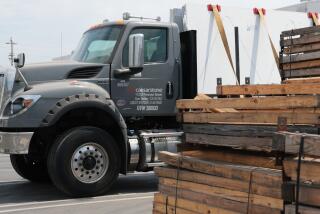Rustic Touch for the Backyard : Rock Makers Offer ‘Natural’ Look
- Share via
The mountains and deserts around Orange County have so many rocks and boulders that a business making them would seem to be a foolish enterprise.
Moving granite and sandstone boulders requires expensive heavy equipment, however, and the real rocks are difficult to fit into swimming pool designs and even more difficult to cement together.
But an increasing number of homeowners who want their backyard pools to look more “natural” and less like cement tubs has produced a growth industry for an Anaheim company that makes “rocks” on-site using steel mesh forms that are covered with concrete.
Rock Formations Inc. was born in 1979 when Bruce Riley, a masonry contractor, began shaping waterfalls around conventional swimming pools. The concept spread and now the company builds pools that utilize hundreds of concrete rocks, shaped into caves, waterfalls, creeks, slides and diving platforms.
“It took a few years to persuade people they would last,” said Riley, who contends that the concrete rocks will last as long as the real thing--”forever.”
Most of the finished concrete rocks weigh between 100 and 1,000 pounds, or about 10% to 50% lighter than the real thing. A concrete rock, which Riley prefers to call “sculptured concrete,” starts out as a shaped steel form covered by wire mesh. A base layer of concrete is sprayed on and a finish layer of mortar is applied by hand. Flakes of mica generally are added to give a granite effect and a reddish tint can be mixed in to achieve sandstone look-alikes.
Latex sheets that have impressions taken from real boulders then are pressed into the wet cement to give it authentic angles and textures.
The finished concrete and mortar layer is about four inches thick, enough to give the heft and solid sound of real rocks.
Except possibly to a geologist, the finished concrete rock is indistinguishable from the smaller real rocks that are often used to complete a pool landscape.
Ever-conscious of “a high degree of detail,” Riley and his brother, Roger, make field trips to the mountains and deserts in the summer to cast the latex impressions from real rocks. In the summer sun, the latex dries quickly and is easily removed. “It’s just like a Halloween mask,” said Roger Riley, the firm’s business manager.
Customers generally select the style of their rock pools from the company’s color slides, and then an engineering company draws plans for the project. Sometimes, a clay model will be made to give the customer a clearer idea of what the finished project will look like.
Strive for a Theme
By blending pool styles with the natural landscape, Riley strives to build pools that evoke a mood or a theme. Some recirculate water through waterfalls that create a mountain environment; a sandstone pool in a natural depression gives a yard the aura of a meditation garden. “People like the idea of blending architectural elements (of their property),” Riley said.
A “natural” swimming pool can be an expensive project. One Orange County project involved the creation of a swimming pool, waterfall, cave, spa and fish ponds. Total cost came to about $200,000 and involved 600 tons of concrete.
But a typical backyard project for Rock Formations costs $10,000, or about double the cost of a plain concrete swimming pool. Such a project will take about two weeks to complete.
Concrete rocks have been used in zoos and theme parks since the 1920s, said Bruce Riley, who got started in the artificial rock business in Washington, making fiberglass rocks for animal habitats at the National Zoo.
Concrete rocks don’t sound hollow and are more realistic in appearance than fiberglass, said Riley, whose business has grown to about $1 million in annual sales and 11 employees.
Techniques Refined
He attributes the growth to refinements in techniques, such as the mica flakes, the iron oxides that produce natural-looking color variations, and the latex skins that give the rock-like texture.
The brothers operate the business from their Anaheim home and park some of their growing fleet of trucks on the lawn. A garage is filled with bags of concrete mixes, latex skins and other equipment; an office in the house is overflowing with pool blueprints and paperwork.
“We’re kinda outgrowing this place,” said Riley, who is in the process of moving the business to Yorba Linda. He concedes that the neighbors probably won’t miss the trucks on the lawn and the half a dozen or so steel mesh rock frames in the backyard.
More to Read
Sign up for Essential California
The most important California stories and recommendations in your inbox every morning.
You may occasionally receive promotional content from the Los Angeles Times.













